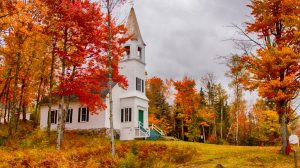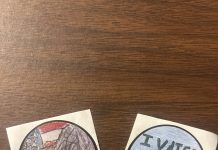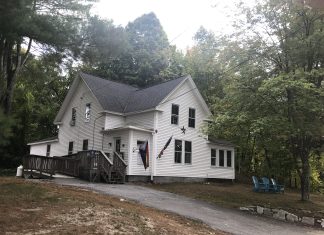Nearing the end of October there were some beautiful pinkish-red shaded leaves in areas of southern NH. Still, overwhelming, this area of the state was painted in a burnished pumpkin-orange and golden-yellow. In my opinion, the colors did appear to have been affected by the drought we experienced last summer because there was less bright-reds than years previous.
Within a 4-6 week period, first emerging in northern NH, and at high elevations, before eventually moving southward, and to lower elevations, along with locations near the coast, autumn foliage follows a “fairly predictable pattern every year,” said Foliage Expert, Jim Salge of New England Today Seasons. But variations are always present from year to year, and depend on weather and climate.
“The brightest and most iconic years,” Salge explained, “are brought about by a solid, New England winter, a seasonably mild and reasonably wet spring, a bright summer that also has adequate rainfall, and most importantly, a dominance of warm, sunny days and clear cool nights in the weeks leading up to autumn.”
But NH didn’t exactly experience a “solid New England winter:” temperatures were above average with limited snowfall. During spring there were also uncharacteristic dips in temperature and several flurries—Concord experienced its lowest April temperature ever, at 4 degrees—according to New England Today Seasons, so “the ground was uncharacteristically bare and trees were budding out well ahead of normal.” Then, of course, summer in southern NH brought little rainfall, causing the area to be classified by the United States Drought Monitor under ‘extreme drought.’
“Drought does usually condense the autumn season, shortening the time between when the colors come in and when the leaves fall,” Salge said, and it can cause color to emerge early but it can also concentrate sugars, which can be favorable for color.
Florence DeLill, who’s been a resident of Dublin since 1976, said every year there are different shades of bright color in NH. “Some years there are more vibrant reds,” she explained. “It’s a lot of yellow (this year) but I’ve enjoyed the foliage very much.”
 Because the fall foliage brings so many tourists to NH—they can always be seen speckling the roadside throughout the months of September and October, snapping photos of the canopy—there are solid ways to track the color’s progress, including websites, like NewEngland.com, which supplies updated reports on the current state of foliage in various sections of New England, apps for the iPhone and Android, and specifically for NH, a hotline through the NH Extension.
Because the fall foliage brings so many tourists to NH—they can always be seen speckling the roadside throughout the months of September and October, snapping photos of the canopy—there are solid ways to track the color’s progress, including websites, like NewEngland.com, which supplies updated reports on the current state of foliage in various sections of New England, apps for the iPhone and Android, and specifically for NH, a hotline through the NH Extension.
In September, the NH Extension hotline’s automated message reported to callers a good deal of southern NH still remained green, but the Merrimack Valley had a golden glow, so tourists should plan visits there in late October when the foliage reached its peak, and that swampy or wet areas are the best places to seek out bold color.
The reason these colors hold consequence (beyond their visual appeal to residents), is that state officials projected 9.5 million visitors to NH this season, according to Dan Seufert of the Union Leader, who would bring in an estimated $1.42 billion in revenue.
But there are actually many factors that contribute to these shades.
“The biggest deterrent is whether or not we have rain and wind,” said Forestry Professor and Specialist, Karen Bennett of the UNH Cooperative Extension.
Bennett, who’s been with the Extension for over 30 years, explained that in mid to late September, the warm days and cool nights with no frost (a foliage killer) are most conducive to a colorful season, while above average temperatures are unfavorable.
But Salge reported that in the case of this season, the snowfall in spring provided some hydration for the leaves just prior to leaf out, which was a much-needed relief due to a lack of hydration.
Some residents of NH saw no difference in the leaves this year in comparison to any others, like residents of Wilton, Theresa Vanblarigan, who said, “I think they’re more bright, more colorful,” and Debbie Greeley, who said, “They looked like fire this year.”
But other NH residents perceived the same leaves in a different light.
Daniel Miess of Concord said, “I found the color was rather muted this year verses others.”
“This year it seemed as though the reds were not as bright, or as plentiful,” said Lindsay Pickering, a resident of Swanzey for the past ten years. “There were lots of yellows.”
This perceptional discrepancy can be explained by the fact that people generally see color on a spectrum.
“Even among people who do not have color blindness,” reported Paul King, a Computational Neuroscientist, “colors are highly salient to some people and less so to others.”
Also, as these comparisons are being made in memory, it’s difficult to quantify the difference in shades short of comparing photographs of this season to past seasons. Even if we laid out photos, our perception of the leaves is subjective. One individual will invariably perceive a certain color as more or less desirable than another.
As no thorough scientific studies have determined a connection between the fall foliage colors and drought conditions, Bennett explained, the season can only be predicted based on known information.
“It is helpful to think of fall foliage as a convergence of chemistry, biology, physics, and psychology (as seasonal depression can cause a ‘last-year-was-brighter syndrome’),” Bennett said.
So, I think I’ve contracted a case of this syndrome this year. But I think there’s more than enough reason to assume that a major lack of hydration would affect most plants, some more than others, certainly. But I still saw the beauty in the canopy, even if I noticed a disparity. Yellow, red, orange, color is color.



















